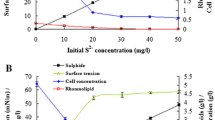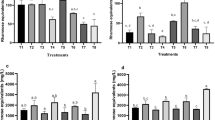Abstract
Rhamnolipids are one of the most well-known classes of biosurfactants having wide applications in various industries due to low toxicity, high biodegradability, and environmentally friendly. Dissolved oxygen (DO) concentration has the crucial effect on rhamnolipids production, particularly through fed-batch cultivation. In this study, the effect of different levels of DO concentrations on rhamnolipid production by Pseudomonas aeruginosa in both batch and fed-batch fermentation was investigated in a lab-scale fermenter under precise DO control. A maximal rhamnolipid production of 22.5 g/l was obtained at a DO concentration of 40% in batch fermentation. In order to achieve the high rhamnolipid production, a fed-batch operation under tight DO control of 40% was conducted. As a result, the overall rhamnolipid production and productivity reached to 240 g/l and 0.9 (g/l h), corresponding to a 10.7 and 4.8-fold improvement compared to the batch experiments. The high level of rhamnolipid production via the fed-batch cultivation can be attributed to both DO concentration and the feeding strategy. This achievement is promising for the production of rhamnolipid in industrial scale.




Similar content being viewed by others
References
Abbasi H, Hamedi MM, Lotfabad TB et al (2012) Biosurfactant-producing bacterium, Pseudomonas aeruginosa MA01 isolated from spoiled apples: physicochemical and structural characteristics of isolated biosurfactant. JBIOSC 113:211–219
Anjum F, Gautam G, Edgard G, Negi S (2016) Biosurfactant production through Bacillus sp. MTCC 5877 and its multifarious applications in food industry. Bioresour Technol 213:262–269
Anvari S, Hajfarajollah H, Mokhtarani B, Noghabi KA (2015) Physiochemical and thermodynamic characterization of lipopeptide biosurfactant secreted by Bacillus tequilensis HK01. RSC Adv 5:91836–91845
Bagheri Lotfabad T, Ebadipour N, Roostaazad R et al (2017) Two schemes for production of biosurfactant from Pseudomonas aeruginosa MR01: applying residues from soybean oil industry and silica sol–gel immobilized cells. Colloids Surf B Biointerfaces 152:159–168
Behrens B, Engelen J, Tiso T et al (2016) Characterization of rhamnolipids by liquid chromatography/mass spectrometry after solid-phase extraction. Anal Bioanal Chem 408:2505–2514
Chen SY, Wei YH, Chang JS (2007) Repeated pH-stat fed-batch fermentation for rhamnolipid production with indigenous Pseudomonas aeruginosa S2. Appl Microbiol Biotechnol 76:67–74
Chong H, Li Q (2017) Microbial production of rhamnolipids: opportunities, challenges and strategies. Microb Cell Fact 16:1–12
Fadhile Almansoory A, Abu Hasan H, Idris M et al (2017) Biosurfactant production by the hydrocarbon-degrading bacteria (HDB) Serratia marcescens: optimization using central composite design (CCD). J Ind Eng Chem 47:272–280
Gámez OR, Rodríguez AA, Cadre JV, Gómez JGC (2017) Screening and characterization of biosurfactant-producing bacteria isolated from contaminated soils with oily wastes. J Environ Treat Tech 5:5–11
Garcia-Ochoa F, Gomez E (2009) Bioreactor scale-up and oxygen transfer rate in microbial processes: an overview. Biotechnol Adv 27:153–176
Hajfarajollah H, Mokhtarani B, Noghabi KA (2014) Newly antibacterial and antiadhesive lipopeptide biosurfactant secreted by a probiotic strain, propionibacterium freudenreichii. Appl Biochem Biotechnol 174:2725–2740
He N, Wu T, Jiang J et al (2017) Toward high-efficiency production of biosurfactant rhamnolipids using sequential fed-batch fermentation based on a fill-and-draw strategy. Colloids Surf B Biointerfaces 157:317–324
Ma KY, Sun MY, Dong W et al (2016) Effects of nutrition optimization strategy on rhamnolipid production in a Pseudomonas aeruginosa strain DN1 for bioremediation of crude oil. Biocatal Agric Biotechnol 6:144–151
Manivasagan P, Sivasankar P, Venkatesan J et al (2014) Optimization, production and characterization of glycolipid biosurfactant from the marine actinobacterium, Streptomyces sp. MAB36. Bioprocess Biosyst Eng 37:783–797
Mondal MH, Malik S, Roy A et al (2015) Modernization of surfactant chemistry in the age of Gemini and biosurfactants: a review. RSC Adv 5:92707–92718
Mondal MH, Sarkar A, Maiti TK, Saha B (2017) Microbial assisted (Pseudomonas sp.) production of novel biosurfactant rhamnolipids and its characterisation by different spectral studies. J Mol Liq 242:873–878
Morikawa M, Hirata Y, Imanaka T (2000) A study on the structure & function relationship of lipopeptide biosurfactants. Biochim Biophys Acta (BBA) Mol Cell Biol Lipids 1488:211–218
Mukherjee S, Das P, Sen R (2006) Towards commercial production of microbial surfactants. Trends Biotechnol 24:509–515
Ochsner UA, Reiser J, Fiechter A, Witholt B (1995) Production of Pseudomonas aeruginosa rhamnolipid biosurfactants in heterologous hosts. Appl Environ Microbiol 61:3503–3506
Pacheco GJ, Reis RS, Fernandes ACLB et al (2012) Rhamnolipid production: effect of oxidative stress on virulence factors and proteome of Pseudomonas aeruginosa PA1. Appl Microbiol Biotechnol 95:1519–1529
Pacwa-Płociniczak M, Płaza GA, Piotrowska-Seget Z, Cameotra SS (2011) Environmental applications of biosurfactants: recent advances. Int J Mol Sci 12:633–654
Reis RS, Pereira AG, Neves BC, Freire DMG (2011) Gene regulation of rhamnolipid production in Pseudomonas aeruginosa—a review. Bioresour Technol 102:6377–6384
Sabra W, Kim EJ, Zeng AP (2002) Physiological responses of Pseudomonas aeruginosa PAO1 to oxidative stress in controlled microaerobic and aerobic cultures. Microbiology 148:3195–3202
Sathi Reddy K, Yahya Khan M, Archana K et al (2016) Utilization of mango kernel oil for the rhamnolipid production by Pseudomonas aeruginosa DR1 towards its application as biocontrol agent. Bioresour Technol 221:291–299
Singh A, Van Hamme JD, Ward OP (2007) Surfactants in microbiology and biotechnology: Part 2. Application aspects. Biotechnol Adv 25:99–121
Sodagari M, Invally K, Ju LK (2018) Maximize rhamnolipid production with low foaming and high yield. Enzyme Microb Technol 110:79–86
Vanavil B (2014) Studies on the effects of bioprocess parameters and kinetics of rhamnolipid production by P. aeruginosa NITT 6L. Chem Biochem Eng Q J 28:383–390
Vecino X, Barbosa-Pereira L, Devesa-Rey R et al (2015) Optimization of liquid–liquid extraction of biosurfactants from corn steep liquor. Bioprocess Biosyst Eng 38:1629–1637
Vecino X, Rodríguez-López L, Gudiña EJ et al (2017) Vineyard pruning waste as an alternative carbon source to produce novel biosurfactants by Lactobacillus paracasei. J Ind Eng Chem 55:40–49
Vera ECS, de Azevedo PODS, Domínguez JM, Oliveira RP (2018) Optimization of biosurfactant and bacteriocin-like inhibitory substance (BLIS) production by Lactococcus lactis CECT-4434 from agroindustrial waste. Biochem Eng J 133:168–178
Wu J, Zhang J, Wang P et al (2017) Production of rhamnolipids by semi-solid-state fermentation with Pseudomonas aeruginosa RG18 for heavy metal desorption. Bioprocess Biosyst Eng 40:1611–1619
Yin H, Qiang J, Jia Y et al (2009) Characteristics of biosurfactant produced by Pseudomonas aeruginosa S6 isolated from oil-containing wastewater. Process Biochem 44:302–308
Zhao J, Wu Y, Alfred AT et al (2013) Chemical structures and biological activities of rhamnolipid biosurfactants produced by Pseudomonas aeruginosa M14808. J Chem Pharm Res 5:177–182
Zhu L, Yang X, Xue C et al (2012) Enhanced rhamnolipids production by Pseudomonas aeruginosa based on a pH stage-controlled fed-batch fermentation process. Bioresour Technol 117:208–213
Author information
Authors and Affiliations
Corresponding author
Electronic supplementary material
Below is the link to the electronic supplementary material.
Rights and permissions
About this article
Cite this article
Bazsefidpar, S., Mokhtarani, B., Panahi, R. et al. Overproduction of rhamnolipid by fed-batch cultivation of Pseudomonas aeruginosa in a lab-scale fermenter under tight DO control. Biodegradation 30, 59–69 (2019). https://doi.org/10.1007/s10532-018-09866-3
Received:
Accepted:
Published:
Issue Date:
DOI: https://doi.org/10.1007/s10532-018-09866-3




